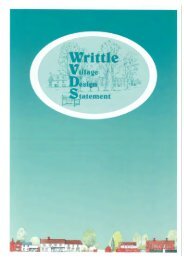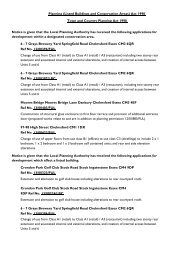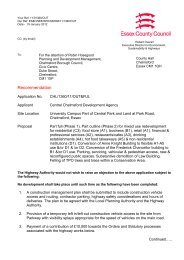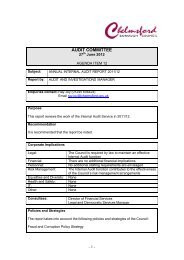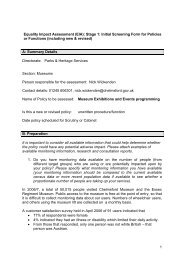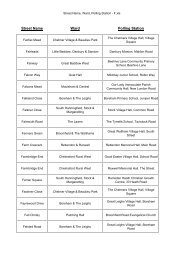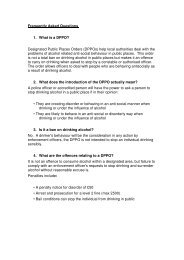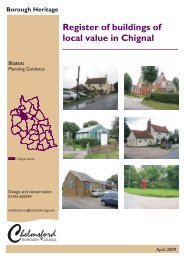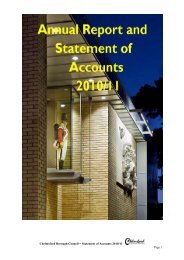Landscape Character Assessment - Chelmsford Borough Council
Landscape Character Assessment - Chelmsford Borough Council
Landscape Character Assessment - Chelmsford Borough Council
Create successful ePaper yourself
Turn your PDF publications into a flip-book with our unique Google optimized e-Paper software.
18 Medieval settlement, in the parish of Ashdon. The remains of a medieval settlement,terraces and platforms spreading 100m across the field immediately east to All SaintsChurch.2.3.15 The 17 th century brought the manor house, many of which were built on the early estates ofthe medieval period. These were usually set within parkland landscapes, such as Audley EndHouse and designed in formal styles influenced by the fashions of the Continent. By the 18 thcentury the Study Area towns were expanding with new trade, the prosperity of which can beseen in some of the buildings such as the churches and the Town Halls. This wealth camefrom wool and silk, however much of the trade and wealth went to neighbouring Colchester.2.3.16 The diverse economic base of the rural economy in the region in the late 16 th century isreflected by a 1582 survey of the manor of Woodham Ferrers which emphasises the presenceof woodland arable and pasture, including grazing marsh, the proximity both to <strong>Chelmsford</strong>and London, ease of water transport via the Crouch estuary and the value of salt productionform the saline water of the estuary. Mounds and earthworks which are the remains of suchsalt production can still be seen in Marsh Farm Country Park, and more extensive and betterpreserved examples lie just across Clements Green Creek at Stow Maries.Utilisation of the Marshes and Mudflats2.3.17 As unreclaimed environments, the marshes provide an important interface between the landand water, and historically have been an important resource for the area’s residents, not onlyproviding a rich and varied source of food, including fish, eels, oysters and wildfowl, but alsoserving as the location for important early industrial activity such as salt making and potteryproduction. The unreclaimed marshes also provided protection. It is within Maldon that thisevidence can be found in its 96.54 kilometres (60 miles) of coastline, including salt marshesand archaeological evidence of an Iron Age port among other sites.2.3.18 Rivers and marshes became the ideal place for industry to grow from as early as the Romanperiod. The retention of the marshes and reclamation of the marshland within the area datesback from the Roman period and has continued through to present day. By the 12 th century,wool was one of Britain’s most important exports. This led to increased pressure onreclamation of the marshlands. Key sites of historical interest in the landscape include: Rat Island: Saltings at the mouth of the Geedon Creek. Abbots Hall farm: 25km of Essex coast and wildlife land. Roman River valley; marsh and woodland fed by springs. Stow Marie’s Halt: Nature reserve on the disused Maldon to Woodham Ferrers railwayline. Tollesbury Wick: Salt marsh land and wildlife habitat. Fingringhoe Wick: West shore of the Colne estuary, land and animal conservation area.2.3.19 The marshland landscapes of the past were ideal in the production of salt. The manufactureof salt (which began in the Bronze Age) flourished in the early Roman period, turning mostof the coastline at certain times into a smokey landscape. By the end of the 1 st century ADthis production went into decline, possibly due to inland salt production sites. TollesburyWick, in Malden, shows us the extent of this production with 242.81 hectares (600 acres) ofsalt marsh land.2.3.20 Fishing and hunting would have been the earliest forms of industry dating from thePalaeolithic to the present day. Fishing in the later periods became more complex as thecreeks and estuaries were used to catch fish.Section 2.0 – Overview of the Study Area11100101R Final LCAs_09-06



